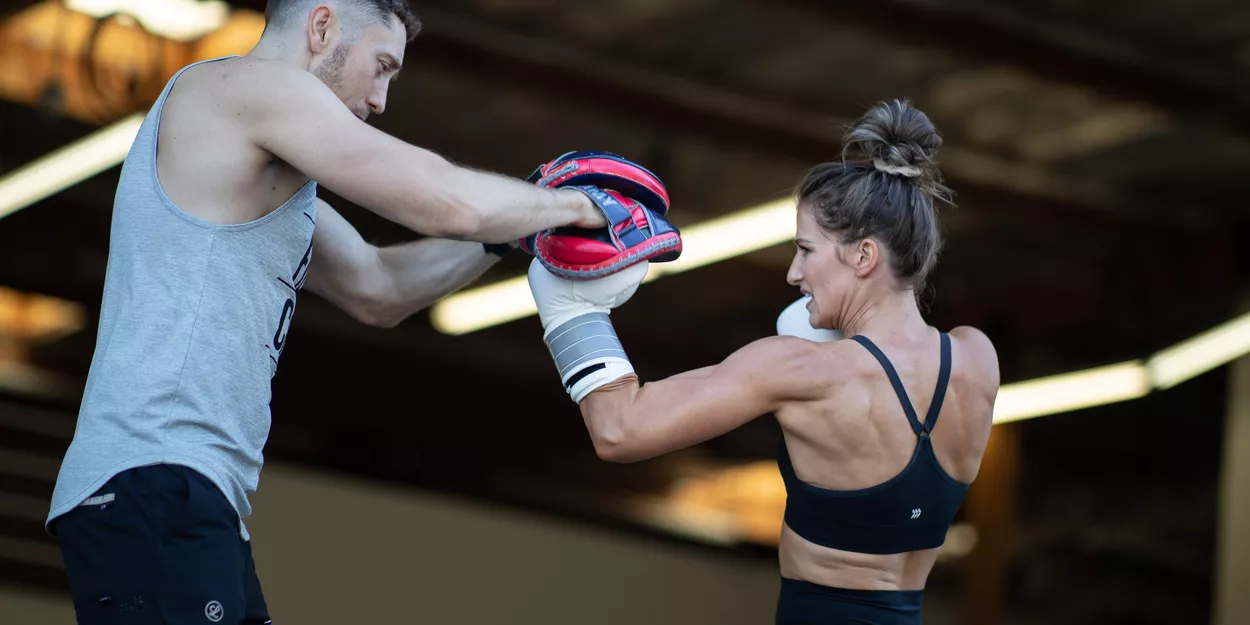

Featured
How Much Exercise Does A Boxer Need
Published: October 4, 2023
Discover how much exercise a boxer needs to stay in peak condition. Get expert insights and tips on the right amount of training for a featured athlete.
Introduction
Boxing is a physically demanding sport that requires athletes to be in peak physical condition. To excel in the ring, boxers need to have strength, speed, endurance, and agility. One of the key factors in achieving these qualities is regular exercise. But how much exercise does a boxer actually need?
In this article, we delve into the world of boxing training and explore the types and duration of exercises that are essential for boxers. Whether you are a professional fighter or someone who enjoys boxing as a form of fitness, understanding the optimal exercise regimen can help you maximize your performance and achieve your goals.
For boxers, exercise goes beyond just staying fit. It is a crucial component of their training routine that directly impacts their performance in the ring. Regular physical activity can enhance cardiovascular fitness, improve muscular strength and endurance, enhance agility and footwork, and enhance overall boxing skills. It can also help boxers maintain a healthy weight and improve mental well-being.
It’s important to note that the exercise needs of boxers may vary based on their weight class, skill level, and training goals. For instance, a professional heavyweight boxer will have different exercise requirements compared to an amateur welterweight fighter. Therefore, it’s essential to tailor the exercise routine to individual needs.
In the sections that follow, we will explore the different types of exercises that are beneficial for boxers and discuss the optimal duration and frequency of training. We will also touch upon the importance of rest and recovery to prevent overtraining and promote optimal performance. So, let’s dive in and discover how much exercise a boxer truly needs.
Benefits of Exercise for Boxers
Regular exercise offers numerous benefits to boxers, both in and out of the ring. Let’s take a closer look at some of the key advantages.
Improved Cardiovascular Fitness: Boxing is a high-intensity sport that requires excellent cardiovascular endurance. Regular aerobic exercise, such as running, skipping rope, or cycling, helps improve the heart and lung function, increasing stamina and allowing boxers to perform at their best for longer durations.
Enhanced Muscular Strength and Endurance: Boxing involves explosive movements and frequent punches, which require significant upper body and core strength. Strength training exercises, such as weightlifting and bodyweight exercises, help develop power, stability, and endurance in the muscles, enabling boxers to generate more force with their punches and last longer in the ring.
Increased Agility and Footwork: Quick and agile footwork is crucial for boxers to move around the ring effectively, evade punches, and create angles for attacking. Agility drills, ladder exercises, and box jumps can improve a boxer’s coordination, speed, and footwork, making them more agile and elusive during fights.
Enhanced Boxing Skills: Skill-specific training is essential for boxers to refine their techniques, accuracy, timing, and defensive maneuvers. Shadowboxing, bag work, pad drills, and sparring allow boxers to practice their punches, combinations, and defensive strategies, ultimately improving their overall boxing skills and ring performance.
Maintained Weight and Body Composition: Regular exercise helps boxers maintain a healthy weight and body composition. It increases calorie expenditure and promotes fat loss while preserving lean muscle mass. This is crucial for boxers, as staying within their weight class is necessary for fair competition and optimized performance.
Improved Mental Well-Being: Exercise releases endorphins, also known as “feel-good” hormones, which can help reduce stress, anxiety, and depression. Boxing workouts provide an excellent outlet for releasing pent-up energy and frustration, promoting mental clarity, focus, and overall well-being.
These are just a few of the many benefits that exercise offers boxers. It is crucial to note that the specific advantages may vary based on individual fitness levels, training goals, and commitment to a well-rounded exercise program.
Types of Exercises for Boxers
Boxing training incorporates a variety of exercises to target different aspects of a boxer’s physical abilities. Below, we explore some of the key types of exercises that boxers should include in their training regimen.
Cardiovascular Training: Aerobic exercise is vital for developing and maintaining a boxer’s cardiovascular fitness. Running, swimming, cycling, and jump rope are excellent choices to improve endurance, boost oxygen uptake, and enhance overall stamina. Boxers should aim for at least 30 minutes of cardiovascular exercise, three to five times a week.
Strength Training: Building strength in the upper body, core, and lower body is essential for generating power in punches and maintaining stability in the ring. Weightlifting exercises, such as bench presses, squats, deadlifts, and overhead presses, help develop overall strength and increase muscle mass. Additionally, bodyweight exercises like push-ups, pull-ups, and planks can be incorporated for functional strength. Strength training should be done two to three times a week, focusing on different muscle groups each session.
Agility and Footwork Training: Quick and precise movements are critical in boxing. Agility ladder drills, cone drills, and ladder footwork exercises improve a boxer’s ability to move quickly, change direction, and maintain balance. These exercises can be done two to three times a week, focusing on agility, coordination, and reaction time.
Skill-Specific Training: To excel in the ring, boxers need to practice their punches, combinations, defense, and ring strategies. Shadowboxing, heavy bag workouts, pad drills with a coach, and sparring sessions with a partner are crucial for developing boxing skills. Skill-specific training should be incorporated multiple times a week to improve technique, precision, timing, and fight-specific movements.
Flexibility and Mobility Training: Flexibility and mobility are often overlooked but are essential for injury prevention and optimal performance in boxing. Stretching exercises, yoga, and mobility drills help improve range of motion, joint stability, and overall flexibility. These exercises can be done two to three times a week, focusing on major muscle groups and areas prone to tightness in boxing, such as the shoulders, hips, and lower back.
By combining these different types of exercises, boxers can develop a well-rounded training program that targets various aspects of their physical abilities. It’s important to work with a qualified coach or trainer to ensure proper technique, progression, and individualized training tailored to one’s specific needs and goals.
Cardiovascular Training
Cardiovascular training is a fundamental component of boxing fitness. It focuses on improving endurance, increasing oxygen uptake, and enhancing overall cardiovascular health. This type of exercise is crucial for boxers as it allows them to maintain a high pace during fights, recover quickly between rounds, and perform at their best for the duration of the match.
Aerobic exercises like running, swimming, cycling, and jump rope are excellent choices for developing cardiovascular fitness. Running is especially beneficial for boxers as it simulates the intensity and demands of a fight. Boxers can incorporate both steady-state runs, where they maintain a moderate pace for an extended period, and interval runs, which involve alternating between high-intensity sprints and recovery periods.
Swimming provides a low-impact alternative to running, offering a full-body workout while placing minimal stress on the joints. It improves cardiovascular endurance, muscular strength, and lung capacity. Cycling, whether on a stationary bike or outdoors, is another effective way to improve cardiovascular fitness. It targets the lower body muscles while providing an excellent cardio workout.
Jumping rope is a classic exercise that not only elevates the heart rate but also enhances footwork, coordination, and rhythm – all essential skills for boxing. Boxers can incorporate jump rope exercises into their warm-up or dedicate specific training sessions solely to jump rope drills.
When it comes to the duration and frequency of cardiovascular training, boxers should aim for at least 30 minutes of moderate to high-intensity exercise, three to five times a week. However, this can vary depending on individual fitness levels, training goals, and upcoming fights. It’s important to gradually increase the intensity and duration of the workouts to avoid overexertion and reduce the risk of injury.
Boxers can also incorporate cross-training activities to add variety and challenge to their cardiovascular workouts. High-intensity interval training (HIIT), circuit training, and plyometric exercises can be effective in boosting cardiovascular fitness while also improving explosive power, agility, and muscular endurance.
Remember that cardiovascular training should be complemented with sufficient rest and recovery days to allow the body to repair and adapt. Boxers should listen to their bodies, monitor their heart rate, and adjust the intensity and duration of their workouts accordingly.
Incorporating regular cardiovascular training into a boxer’s routine is essential for maintaining optimal fitness levels, improving endurance, and enhancing overall performance in the ring. By committing to consistent cardio workouts, boxers can enter the ring with confidence, knowing that they have the stamina and cardiovascular capacity to handle the physical demands of the sport.
Strength Training
Strength training is a critical component of a boxer’s training regimen as it helps develop the power, stability, and muscular endurance necessary for effective punches, defensive maneuvers, and overall performance in the ring. By incorporating specific exercises that target the upper body, core, and lower body, boxers can enhance their strength, improve their punching power, and withstand the physical demands of the sport.
Weightlifting exercises are commonly used in strength training for boxers. Compound movements such as bench presses, squats, deadlifts, and overhead presses are effective in building overall strength and muscle mass. These exercises engage multiple muscle groups, including the chest, back, arms, shoulders, legs, and core. It’s important to focus on proper technique, gradually increase the weight lifted, and aim for a moderate number of repetitions (8-12) per set to promote both strength and muscle growth.
In addition to traditional weightlifting, bodyweight exercises are beneficial for developing functional strength that directly translates to boxing movements. Push-ups, pull-ups, dips, planks, and lunges are all excellent bodyweight exercises that can be incorporated into a boxer’s strength training routine. These exercises enhance muscular endurance and stability while also improving core strength, which is vital for generating power in punches.
Circuit training, where a series of exercises are performed consecutively with minimal rest, can also be effective for developing strength and cardiovascular fitness simultaneously. By combining strength exercises with cardio-based movements such as burpees, mountain climbers, or kettlebell swings, boxers can challenge their muscles, elevate their heart rate, and improve their overall conditioning.
When it comes to the frequency of strength training, boxers should aim for two to three sessions per week, focusing on different muscle groups each session. Adequate rest and recovery days should be incorporated to allow the muscles to repair and grow stronger. Boxers should also consider working with a qualified strength and conditioning coach who can provide personalized guidance and ensure proper form and technique.
It’s important to note that strength training programs should be tailored to the individual boxer’s needs, taking into account factors such as weight class, training goals, and injury history. Working with a professional can help create a customized plan that maximizes strength gains while minimizing the risk of overtraining or injury.
By incorporating proper strength training into their routine, boxers can enhance their punching power, improve their overall stability and durability, and have a competitive advantage in the ring. Building strength not only enhances performance but also reduces the risk of injury, ensuring boxers can continue to train and compete at their highest level.
Agility and Footwork Training
Agility and footwork are essential components of a boxer’s skill set. The ability to move quickly, change direction fluidly, and maintain balance is crucial for evading punches, creating angles for attack, and maximizing overall performance in the ring. By incorporating specific agility and footwork training exercises, boxers can enhance their speed, coordination, and agility.
Agility ladder drills are highly effective in improving footwork and quickness. These drills involve various foot patterns, such as lateral hops, high knees, and in-and-out movements, performed in a ladder formation on the ground. These exercises improve foot speed, coordination, and the ability to rapidly change direction, enhancing a boxer’s ability to evade punches and create openings for counterattacks.
Cone drills are another effective way to improve agility and footwork. By setting up a series of cones in different formations, boxers can simulate specific movement patterns and practice quick changes in direction. These drills not only enhance footwork but also challenge balance, coordination, and reaction time.
Box jumps are a valuable exercise for developing explosive power, lower body strength, and coordination. By jumping onto and off of a box or platform, boxers can improve their vertical leap, lower body strength, and overall stability. Box jumps help develop the explosive power needed for explosive punches and quick movements in the ring.
Incorporating ladder drills, cone drills, and box jumps into a boxer’s training routine can be done two to three times a week. These exercises should be performed with proper technique and focus on quality over quantity. It’s essential to start with simple drills and gradually progress to more complex and challenging movements.
Another important aspect of agility and footwork training is practicing defensive movements such as slips, rolls, and pivots. These movements, often combined with shadowboxing or partner drills, help boxers improve their defensive skills by teaching them how to effectively dodge punches and maintain balance while moving laterally. These drills can be incorporated into a boxing skill-specific training session multiple times a week.
It’s important to note that agility and footwork training should be complemented by proper flexibility and mobility exercises. Stretching, yoga, and mobility drills help improve range of motion, joint stability, and overall flexibility, allowing boxers to move with ease and prevent injuries during fast movements and direction changes.
By incorporating regular agility and footwork training into their routine, boxers can enhance their overall movement, speed, coordination, and defensive capabilities. These exercises not only improve performance in the ring but also contribute to better body control, balance, and injury prevention.
Skill-Specific Training
Skill-specific training is a crucial aspect of a boxer’s training regimen as it focuses on refining their boxing techniques, improving accuracy, timing, defensive maneuvers, and overall ring strategy. By incorporating specific exercises that simulate the movements and demands of a boxing match, boxers can enhance their skills and elevate their performance in the ring.
Shadowboxing is a fundamental skill-specific exercise that allows boxers to practice their techniques without a partner or equipment. It involves visualizing an opponent and executing punches, defensive movements, footwork, and combinations. Shadowboxing not only improves muscle memory and accuracy but also helps develop endurance and cardiovascular fitness.
Working with a heavy bag is another essential component of skill-specific training. The heavy bag provides a target for punches and allows boxers to practice their power, speed, and combinations. This helps in refining technique, developing coordination, and building upper body strength. It is important to focus on maintaining proper form, balance, and rhythm while engaging with the heavy bag.
Pad drills, when performed with a coach or training partner, are highly effective for improving accuracy, timing, and reaction speed. These drills involve a coach holding pads for the boxer to strike with specific combinations or defensive moves. Pad drills allow boxers to practice their punches with precision, enhance hand-eye coordination, and develop defensive techniques.
Sparring, under supervision and with appropriate safety precautions, is an essential part of skill-specific training for boxers. It provides an opportunity to put techniques, strategies, and defensive moves into action against a live opponent. Sparring helps boxers improve their ability to react to different styles, adapt their punches, and develop ring awareness. It also helps build mental toughness and confidence in the ring.
Aside from these specific exercises, boxers should also focus on other essential skills such as footwork, head movement, and ring generalship. Footwork drills involve practicing pivots, lateral movements, and angles to enhance agility and create opportunities for attack or defense. Head movement exercises, such as slipping and rolling, improve defensive capabilities and enable boxers to avoid punches effectively.
It is recommended to incorporate skill-specific training multiple times a week, alternating between different exercises. This helps boxers refine their techniques, improve accuracy, and develop a better understanding of their strengths and weaknesses in the ring. Working with a knowledgeable coach or trainer can provide valuable feedback and guidance during skill-specific training sessions.
Remember, skill-specific training must be performed with proper technique, focus, and control to yield desired results. Consistent practice and dedication to skill development are key to mastering the art of boxing and achieving success in the ring.
Duration and Frequency of Exercise
The duration and frequency of exercise for boxers depend on various factors such as training goals, fitness levels, and upcoming fights. It is crucial to strike a balance between challenging workouts and avoiding overtraining to achieve optimal results. Here are some general guidelines for the duration and frequency of exercise in boxing:
Duration: The duration of exercise sessions can vary based on the type of training and individual fitness levels. Cardiovascular exercises like running or jump rope should typically be done for a minimum of 30 minutes to effectively raise the heart rate and improve endurance. Strength training sessions should last around 45 minutes to an hour, allowing enough time for proper warm-up, working sets, and cool-down. Skill-specific training, such as shadowboxing or pad drills, can range from 15 to 30 minutes, focusing on technique, precision, and intensity.
Frequency: The frequency of exercise sessions depends on the boxer’s training program and their ability to recover adequately. As a general guideline, boxers should aim for cardiovascular exercises three to five times a week. Strength training should be done two to three times a week, with rest days in between to allow for muscle repair and growth. Skill-specific training can be incorporated multiple times a week, depending on the boxer’s skill level and training goals. It is important to listen to the body and avoid excessive training that may lead to overuse injuries or burnout.
It is important to note that the duration and frequency of exercise should be adjusted according to the boxer’s workload and upcoming fights. During intense training periods, such as preparing for a fight, the frequency and duration of exercise sessions may be increased. Conversely, during rest and recovery phases, the frequency and duration may be reduced to allow the body to heal and regenerate.
It is recommended for boxers to work with a knowledgeable coach or trainer who can provide personalized guidance and tailor the exercise program to individual needs. This ensures that the right balance of duration and frequency is achieved to optimize both performance and physical well-being.
Remember, consistency and gradual progression are key in a boxer’s training journey. Building a solid foundation and gradually increasing the intensity, duration, and frequency of exercises will lead to long-term improvement and success in the ring.
Rest and Recovery
Rest and recovery are crucial components of a boxer’s training regimen. While intense workouts are necessary to improve performance, it is during the rest and recovery phase that the body repairs and adapts, leading to gains in strength, endurance, and overall athletic ability. Ignoring or neglecting rest and recovery can lead to overtraining, increased risk of injuries, and hindered progress. Here are some key points to consider:
Sleep: Getting adequate sleep is paramount for effective recovery. During sleep, the body releases growth hormones, repairs damaged tissues, and consolidates learning and skill development. Aim for at least 7 to 9 hours of quality sleep each night to support optimal recovery and performance.
Active Rest: Active rest days involve engaging in low-intensity activities or alternative forms of exercise that promote recovery without placing excessive stress on the body. Light cardio, yoga, stretching, or mobility exercises can help improve blood circulation, flexibility, and aid in muscle recovery.
Nutrition: Proper nutrition plays a vital role in recovery. Consuming a balanced diet featuring a variety of whole foods, lean proteins, healthy fats, and complex carbohydrates provides the necessary nutrients for repairing muscles and replenishing energy stores. Adequate hydration is also essential for supporting optimal recovery and overall performance.
Recovery Techniques: Various recovery techniques can aid in reducing muscle soreness and promoting recovery. This includes foam rolling, stretching, massage, and contrast water therapy (alternating between hot and cold water). These techniques help improve blood flow, alleviate muscle tension, and enhance overall recovery.
Listen to Your Body: It is important to pay attention to your body’s signals and adjust the training intensity or take rest days when needed. Pushing through excessive fatigue or ignoring pain can lead to overuse injuries and setbacks. Rest when you are feeling excessively fatigued, experiencing persistent soreness, or dealing with any injury.
Periodization: Implementing a periodized training program can help optimize rest and recovery. Periodization involves dividing training into different cycles, alternating between high-intensity and lower-intensity phases. This allows for proper recovery and prevents overtraining, while still progressing towards long-term goals.
Remember, rest and recovery are not signs of weakness but necessary components of a well-rounded training program. By prioritizing adequate rest, allowing for recovery, and incorporating targeted recovery techniques, boxers can optimize their performance, minimize the risk of injury, and achieve long-term success in their boxing journey.
Conclusion
In conclusion, exercise plays a vital role in the training and preparation of boxers. Understanding the optimal duration, frequency, and types of exercises is crucial for maximizing performance and achieving success in the ring.
Boxers can benefit from various types of exercises, including cardiovascular training, strength training, agility and footwork training, and skill-specific training. Cardiovascular exercises enhance endurance, strength training builds power and stability, agility and footwork training improve speed and coordination, and skill-specific training refines techniques and enhances overall boxing skills.
The duration and frequency of exercise should be tailored to individual needs, taking into account factors such as training goals, fitness levels, and upcoming fights. Consistency and gradual progression are key, ensuring a balance between challenging workouts and necessary rest and recovery periods.
Rest and recovery should not be overlooked, as they are vital for the body to repair, adapt, and avoid overtraining. Adequate sleep, active rest days, proper nutrition, and recovery techniques such as foam rolling and stretching are essential components of effective recovery.
By incorporating a well-rounded exercise program that includes cardiovascular fitness, strength training, agility and footwork training, and skill-specific exercises, boxers can optimize their physical capabilities and improve their performance in the ring. Working with qualified coaches or trainers can provide guidance and personalized programs to meet individual needs and goals.
Remember, boxing is not just a physical sport but also a mental one. Building a strong foundation through proper exercise, rest, and recovery will not only enhance physical abilities but also improve mental focus, endurance, and overall well-being inside and outside the ring.








